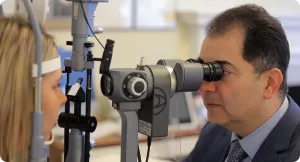How Long Will ICL Last? A Guide to Longevity and Outcomes

If you’ve been researching permanent vision correction, you may have heard of Implantable Collamer Lens (ICL) surgery. Unlike LASIK, which reshapes the cornea, ICL surgery involves placing a small, artificial lens inside your eye to correct refractive errors.
Naturally, one of the first questions patients ask is: How long will ICL last? It’s an important question because you want to know whether the results are truly permanent, whether the lens ever needs replacing, and what happens to your vision as you get older.
In this article, I’ll explain the expected lifespan of ICLs, discuss how stable the results are over time, and give you an honest look at what to expect for your long-term vision.
What Exactly Is ICL?
ICL stands for Implantable Collamer Lens, a revolutionary vision correction solution designed for people who want clear eyesight without relying on glasses or contact lenses. The lens itself is made from a special biocompatible material called collamer, which is a type of collagen copolymer. This unique material is highly compatible with the human eye, meaning it is safe for long-term implantation and does not typically cause irritation or rejection.
Unlike external corrective devices, the ICL is surgically implanted directly into the eye. Specifically, it is placed between the iris the coloured part of your eye and your natural lens. Once in position, the lens works seamlessly with your eye’s natural structures to bend and focus light precisely onto the retina. This precise focusing helps produce sharp, clear vision at multiple distances, significantly reducing or even eliminating the need for glasses or contact lenses.
One of the major advantages of ICL over laser-based procedures such as LASIK or PRK is that it does not involve removing or reshaping the corneal tissue. Because of this, ICL is often considered a safer option for people who have thinner corneas, irregular corneal shapes, or very high prescriptions that make laser surgery less suitable. Additionally, because the lens is flexible and reversible, it provides a long-term yet adaptable solution for vision correction, offering patients a level of safety and reliability that many find reassuring.
How Long Does an ICL Lens Last?

One of the most significant advantages of ICL (Implantable Collamer Lens) surgery is the incredible longevity of the lens itself. The ICL is designed to stay in your eye for a lifetime, providing clear vision without the need for ongoing replacements. Made from a highly stable and biocompatible material called collamer, the lens is resistant to breaking down or wearing out over time, which makes it a reliable long-term solution for vision correction.
In most cases, once the ICL is implanted, it remains in place permanently. Patients rarely need to have the lens removed or replaced, and the results tend to remain consistent for decades. Because the material is designed specifically to integrate safely with the structures of the eye, it generally does not cause irritation, inflammation, or other long-term complications.
That said, while ICL lenses are extremely durable, there are rare situations in which a lens may need to be removed or exchanged. For example, if a patient develops other eye conditions, experiences changes in vision that require a different prescription, or encounters unexpected complications, the lens can be safely replaced by an experienced eye surgeon. These cases are uncommon, but it’s important to know that the option exists if needed.
Overall, the long-lasting nature of ICL makes it an appealing choice for anyone looking for a permanent alternative to glasses or contact lenses. It combines advanced material science with precision implantation to provide reliable, high-quality vision for years to come.
Is ICL Permanent?
Yes, ICL (Implantable Collamer Lens) provides permanent vision correction, offering a long-term solution for people looking to reduce or eliminate their dependence on glasses or contact lenses. Once implanted, the lens remains in your eye for many years, often for a lifetime, delivering consistently clear vision without the need for ongoing maintenance or replacement in most cases.
However, one of the unique advantages of ICL is that it is also reversible. Unlike LASIK or other laser-based procedures that permanently reshape the cornea, the ICL does not alter your natural eye structures. This means that if necessary, the lens can be safely removed or exchanged by a qualified surgeon.
This combination of permanence and reversibility is what sets ICL apart from other vision correction methods. It offers the reassurance of a long-lasting solution while still allowing for adjustments if your visual needs change in the future.
Will ICL Need Replacing in the Future?

Most patients never need their ICL replaced. However, there are a few scenarios where replacement may be necessary:
- Prescription changes: If your vision changes significantly over time, the lens may be swapped for a stronger or weaker version.
- Cataracts: If you develop cataracts later in life, the ICL will be removed during cataract surgery.
- Complications: Rarely, issues such as increased eye pressure or improper sizing might require replacement.
These cases are uncommon, and most patients enjoy stable results for decades without additional procedures.
How Long Will Vision Stay Clear After ICL?
One of the biggest benefits of ICL surgery is how quickly patients notice an improvement in their eyesight. For most people, vision becomes clearer almost immediately after the procedure, and many achieve 20/20 vision or even better within a short recovery period. This dramatic and rapid improvement is one of the reasons ICL has become such a popular option for long-term vision correction.
The clarity provided by the ICL itself is designed to last a lifetime. Because the lens is made of a stable, biocompatible material that does not wear out or degrade, patients can expect their corrected vision to remain consistent for decades. In other words, once implanted, the ICL continues doing its job effectively without requiring adjustments or replacements in the vast majority of cases.
That said, it’s important to remember that while the lens remains unchanged, your natural eyes will continue to age. This means that certain age-related vision changes can still occur, even with an ICL in place. For example, presbyopia the gradual loss of near vision typically begins in your 40s and is a normal part of ageing. This condition affects everyone, regardless of whether they have had ICL or not, and often leads to the need for reading glasses.
Comparing ICL Longevity to LASIK
When it comes to long-term vision correction, it’s helpful to compare ICL with LASIK, since both are widely chosen options but work in very different ways. Each has its own strengths, and the right choice depends on your prescription and eye health.
LASIK corrects vision by permanently reshaping the cornea with a laser. While this can provide excellent clarity, the results may change gradually over time, especially if your prescription is high or if your eyes naturally change with age. Because the corneal tissue is altered, the procedure cannot be reversed, which means it is a lifelong change.
ICL, on the other hand, offers a permanent solution that is also reversible. The lens is implanted inside the eye without removing or reshaping corneal tissue, which makes the results more stable in the long run. If your vision changes significantly in the future, the lens can be safely removed or replaced, giving patients extra reassurance.
In terms of longevity, ICL often delivers more predictable stability, particularly for patients with thin corneas or higher prescriptions where LASIK might not be the best choice. This is one of the reasons ICL is often recommended for people seeking a long-term solution with fewer uncertainties.
Advantages of ICL Longevity
Knowing that ICL is designed to last a lifetime offers several important benefits for patients considering this procedure. It not only provides long-term clarity but also reassurance that the investment in your vision is truly lasting.
Peace of mind: With ICL, you don’t need to worry about replacing the lens every few years. Once it’s implanted, it stays in place and continues working effectively for decades, which makes it a reliable long-term solution.
Stable results: Because the lens works in harmony with your eye’s natural structures, the results remain consistently clear over time. This stability is especially valuable for people with high prescriptions, who might otherwise experience regression with other treatments.
Reversibility: If your vision needs change in the future, the ICL can be safely removed or replaced without damaging your eye. This flexibility offers a level of security that most other permanent vision correction procedures do not provide.
Biocompatibility: The collamer material used to make the lens is designed to integrate seamlessly with your eye. Since it is highly biocompatible, it reduces the risk of long-term irritation or rejection, allowing patients to enjoy comfort along with clarity.
This unique combination of permanence, stability, and flexibility makes ICL one of the most attractive options available for those seeking dependable vision correction. It gives patients both the confidence of lasting results and the comfort of knowing future adjustments are still possible.
Scenarios Where ICL May Not Last Forever
Although ICL is designed to last a lifetime, there are certain situations where adjustments or replacements may be necessary. Understanding these scenarios can help set realistic expectations and provide reassurance that solutions exist if changes occur.
Eye Health Changes
Conditions such as cataracts or glaucoma may require removal or replacement of the lens. While these changes are generally related to aging or other eye health issues, modern surgical techniques make it safe to adjust the ICL if needed.
Prescription Shifts
Although most people’s prescriptions stabilise by their mid-20s, some may experience changes later in life. In such cases, a new ICL or an adjustment may be required to maintain optimal vision, ensuring you continue to see clearly.
Complications
Rare complications, such as lens rotation, incorrect sizing, or increased eye pressure, may also lead to replacement. These situations are uncommon, but they can typically be resolved effectively by an experienced eye surgeon.
Fortunately, these scenarios are exceptions rather than the rule, and the vast majority of patients enjoy long-term, stable vision without needing any adjustments. Knowing this can help you feel confident in choosing ICL as a reliable, durable vision correction option.
How Do You Know If Your ICL Is Still Working?
Most patients enjoy clear, sharp vision for many years after ICL implantation, but regular check-ups are essential to ensure everything remains in optimal condition. Routine examinations help catch any changes early and maintain the long-term success of your procedure.
During these visits, your ophthalmologist will carefully assess several key factors:
- Lens position: Ensuring the ICL remains correctly aligned in the eye is critical for consistent vision quality.
- Eye pressure: Measuring intraocular pressure helps detect early signs of glaucoma or other pressure-related issues.
- Corneal health: Checking the cornea ensures there is no stress or damage from the implanted lens.
- Retinal health: Examining the retina confirms that the back of the eye is functioning well and that vision remains clear.
These regular assessments give your eye care professional the information needed to confirm that your ICL continues to function perfectly. They also provide peace of mind, knowing that your long-term vision is being carefully monitored.
Can ICL Be Removed?
Yes, and this reversibility is one of the ICL’s biggest advantages. If needed, your surgeon can remove or replace the lens in a relatively straightforward procedure, without causing damage to your natural eye structures.
There are several reasons why an ICL might be removed:
- Prescription changes: If your vision changes significantly over time, a new lens can be implanted to restore optimal clarity.
- Development of cataracts: If cataracts form, the ICL may be removed as part of cataract surgery to ensure continued good vision.
- Rare complications: In uncommon cases, issues such as lens rotation or sizing problems may require removal or replacement.
Knowing that the lens is reversible provides patients with extra peace of mind and confidence when choosing this procedure. It combines the benefits of long-term vision correction with the safety of an option to adjust if circumstances change.
Patient Experiences Over Time
Research and long-term studies show that patient satisfaction rates with ICL remain consistently high, even decades after implantation. Many patients report clearer vision, particularly at night, and greater overall visual comfort compared to those who have undergone LASIK.
For most people, ICL provides reliable, stable vision correction for many years. Eventually, natural ageing processes such as presbyopia or cataracts may require additional care, but the ICL continues to function effectively until such changes occur. Overall, patients often describe the procedure as life-changing, with the convenience of reduced dependence on glasses or contact lenses being a major benefit.
Who Is the Best Candidate for Long-Term ICL Success?
You may be an ideal candidate for ICL if certain conditions are met. Generally, patients between the ages of 21 and 45 tend to achieve the best long-term outcomes, as their prescriptions have typically stabilised and their eyes are healthy enough for safe implantation.
Your prescription should have remained stable for at least a year before surgery. This ensures that the implanted lens will provide accurate, lasting vision correction without being affected by recent fluctuations.
ICL is particularly suitable for individuals with thin corneas or high myopia, conditions that can make LASIK or other laser procedures less safe or effective. These patients often benefit from the stability and predictability that ICL offers.
It’s also important that your eyes are otherwise healthy, free from significant conditions such as glaucoma, severe cataracts, or retinal issues. A comprehensive eye examination will confirm whether you meet these requirements and help your surgeon plan the procedure safely.
If you’re considering ICL surgery in London, a professional consultation will assess your suitability and provide guidance on achieving the best long-term results. This step ensures your vision correction is not only effective but also sustainable for years to come.
The Role of Aftercare in Longevity
After ICL surgery, carefully following your aftercare plan is essential to ensure the lens performs optimally for years to come. Proper aftercare not only supports healing but also helps maintain the clarity and stability of your vision.
Use any prescribed eye drops exactly as directed by your surgeon. These medications help prevent infection and reduce inflammation, promoting a smooth recovery.
Avoid rubbing your eyes during the initial healing period. Even minor pressure on the eye can affect the lens position or slow down recovery, so gentle handling is crucial.
Attend all scheduled follow-up appointments with your ophthalmologist. These visits allow your surgeon to monitor the lens, check eye pressure, and ensure that your eyes are healing correctly.
Protect your eyes from trauma and excessive UV exposure. Wearing protective eyewear outdoors or during activities that risk eye injury helps maintain both the health of your eyes and the long-term success of your ICL.
By following these habits, patients can significantly support the durability and effectiveness of their implanted lens, ensuring clear, stable vision for many years.
Common Myths About ICL Longevity
It’s normal to have questions about how long ICL lasts, so let’s clear up a few common misconceptions. Understanding the facts can help you make a confident decision about your vision correction options.
Myth: The lens wears out after 10 years.
Truth: The ICL is designed to last a lifetime. Its biocompatible material remains stable in the eye and does not break down over time, meaning replacement is rarely needed.
Myth: You’ll definitely need a replacement.
Truth: Most people never require a second surgery. The lens continues to provide clear, stable vision for decades, and adjustments are only necessary in exceptional cases such as major prescription changes or rare complications.
Myth: ICL prevents cataracts forever.
Truth: Cataracts are an age-related change in the natural lens and can still develop, even in eyes with an ICL. While the ICL corrects vision, it does not stop the natural ageing process of your eyes.
By separating fact from fiction, patients can better understand the long-term benefits and realistic expectations of ICL, making it easier to plan for clear vision well into the future.
FAQs About ICL Longevity
- How long does an ICL last?
ICL is designed to remain in your eye for a lifetime. The lens is made from biocompatible collamer material, which does not break down or wear out over time. Most patients enjoy stable, clear vision for decades without needing replacement. - Is ICL permanent?
Yes, ICL provides permanent vision correction. Unlike LASIK, it doesn’t reshape the cornea, and yet it’s reversible if needed. This means the lens can be safely removed or replaced in the future if your vision changes. - Will I ever need my ICL replaced?
Most patients never require replacement. Replacement may only be necessary in rare situations, such as significant prescription changes, the development of cataracts, or uncommon complications like lens rotation or improper sizing. - Does ICL prevent age-related vision changes?
No. While ICL corrects refractive errors like myopia or hyperopia, it cannot stop natural ageing changes such as presbyopia (difficulty reading up close) or cataracts. These conditions may require additional treatment later in life. - How soon after surgery will I see clearly?
Vision improvement is usually immediate. Most patients notice sharper eyesight within a day or two, achieving 20/20 vision or better shortly after the procedure. - How does ICL compare to LASIK in terms of longevity?
LASIK permanently reshapes the cornea, but results can regress over time. ICL, however, provides stable, long-lasting results because it doesn’t alter corneal tissue and can be removed or replaced if necessary. - What kind of follow-up care is needed to maintain ICL longevity?
Regular check-ups with your ophthalmologist are essential. These appointments ensure the lens is correctly positioned, eye pressure is normal, and your cornea and retina remain healthy. Using prescribed eye drops and avoiding eye trauma also supports long-term results. - Can ICL be removed safely?
Yes. If necessary, a surgeon can remove or replace the lens through a relatively straightforward procedure. Reversibility is a key advantage that adds confidence and flexibility for patients. - Who is the best candidate for long-term ICL success?
Ideal candidates are typically aged 21–45, have a stable prescription for at least a year, possess thin corneas or high myopia that makes LASIK unsuitable, and have otherwise healthy eyes. A consultation will confirm suitability and ensure optimal long-term outcomes. - What should I do if my vision changes after ICL?
If you notice any changes in your vision, it’s important to schedule an eye exam. While most changes are age-related, your ophthalmologist can check the lens, monitor eye health, and recommend whether adjustment or replacement is necessary.
Final Thoughts: Is ICL Right for You?
ICL surgery can be a life-changing option, giving you the freedom of clear vision without relying on glasses or contact lenses. However, it’s not suitable for everyone. Your age, prescription stability, corneal health, and any existing eye conditions all play a key role in determining whether ICL is the safest and most effective choice for you.
Taking the time to understand these factors ensures you make an informed decision and achieve the best possible outcome. If you want to explore the most suitable options for ICL surgery in London, you can contact us at Eye Clinic London, where our expert team provides a thorough assessment and personalised advice tailored to your unique vision needs.
References:
- Kamiya, K., Shimizu, K., Igarashi, A., Shiratani, T., “Long-term comparison of posterior chamber phakic intraocular lens with and without a central hole implantation for moderate to high myopia and myopic astigmatism,” Medicine (Baltimore), 95(14): e3270, https://pmc.ncbi.nlm.nih.gov/articles/PMC4907705/
- Zhang, X., Chen, X., “Five-year outcomes of EVO implantable collamer lens for correction of high and super-high myopia,” Eye & Vision, 8:26, 2021. https://eandv.biomedcentral.com/articles/10.1186/s40662-021-00264-0
- Montés-Micó, R., Ruiz-Mesa, R., Rodríguez-Prats, J.L., Tañá-Rivero, P., “Posterior-chamber phakic implantable collamer lenses with a central port: a review,” Acta Ophthalmologica, 99(3): e288–e301, 2021. https://eandv.biomedcentral.com/articles/10.1186/s40662-021-00247-1
- Ye, Y., et al., “Long-term evaluation of anterior lens density after ICL V4c implantation,” British Journal of Ophthalmology, 106(11): 1508–1513, 2022. https://bjo.bmj.com/content/106/11/1508
5. “Safety of Implantable Collamer Lens (ICL): 10 years follow-up,” Investigative Ophthalmology & Visual Science, [journal article], 10-year safety findings report. https://iovs.arvojournals.org/article.aspx?articleid=2642147

